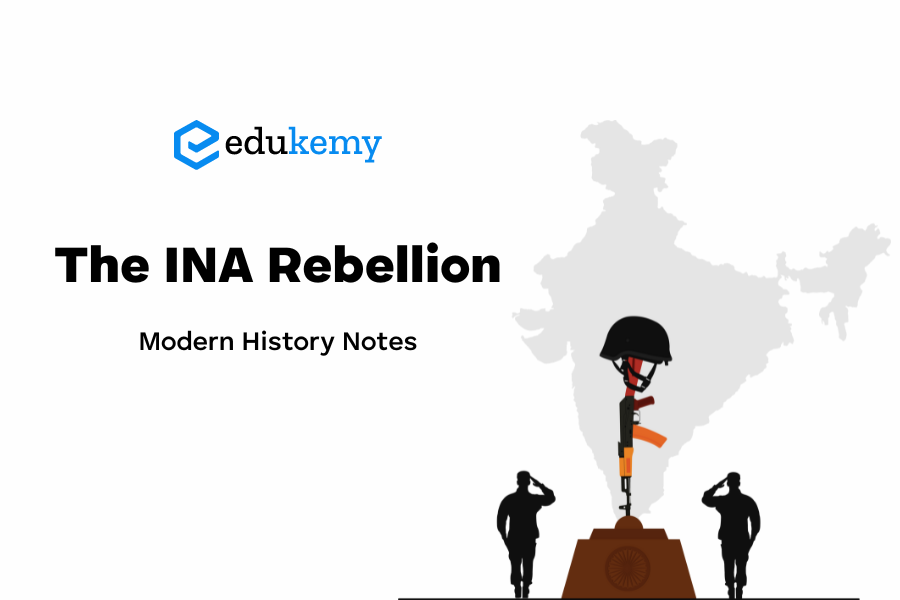- The INA Rebellion, also known as the Indian Armed Forces Mutiny, was a significant turning point in India’s struggle for independence. It followed the release of three INA members (Shahnawaz Khan, Prem Sahgal, and Gurbaksh Dhillon) after their trial, and it played a crucial role in weakening the British hold over India. Here’s an overview of its background, events, and importance:
Contents
Background:
- Despite the release of the three INA members, the British Indian Army proceeded with the trials of the rest of the captured INA troops.
- Indian Army officers and pilots of the Royal Indian Air Force (RIAF) initiated a massive strike in January 1946. The ships of the Royal Indian Navy (RIN) also joined the mutiny in February, and civilians in Mumbai joined the strikes too.
- This mass mutiny showcased the shifting loyalties of the Indian armed forces towards the nation and their resistance to British pressure.
INA Rebellion:
- The campaign for the release of INA prisoners gained widespread publicity through extensive press coverage, public meetings, and celebrations of INA Day.
- The agitation spread to various regions in India, and different groups, including political parties like the Congress, Muslim League, Communist Party, and others, expressed their support for the INA cause.
- The rebellion questioned Britain’s authority to decide matters concerning Indians and represented the growing militancy in the popular mindset.
Importance of the Rebellion:
- The fearless action by the masses and the revolt in the armed forces had a liberating effect on the Indian people’s minds.
- British Prime Minister Clement Attlee acknowledged that the INA activities under Netaji Subhas Chandra Bose had weakened the Indian Army, which was the foundation of British rule in India.
- The rebellion demonstrated that the Indian armed forces could no longer be relied upon to support British rule.
- The INA and the various revolts, mutinies, and public resentments played a vital role in the complete withdrawal of British rule from India.
- The British government came to realize that the Indian independence movement had gained significant strength and that granting dominion status to India after the war was no longer enough to maintain control.
- In conclusion, the INA Rebellion marked a pivotal moment in India’s quest for freedom. The collective resistance by the masses and the mutinies within the Indian armed forces showcased the growing determination and unity of the Indian people against British rule. The rebellion hastened the process of India gaining independence and demonstrated the weakening grip of the British Empire over the Indian subcontinent.
Frequently Asked Questions (FAQs)
1. What was the Indian National Army (INA) Rebellion?
Answer: The INA Rebellion refers to the uprising and military actions led by the Indian National Army during World War II against British colonial rule in India. The INA was formed by Netaji Subhas Chandra Bose in 1942 to liberate India from British control. Comprising Indian soldiers who were prisoners of war and civilians in Southeast Asia, the INA played a crucial role in the struggle for independence, particularly in the Burma Campaign.
2. What motivated Subhas Chandra Bose to form the Indian National Army?
Answer: Subhas Chandra Bose formed the Indian National Army with the belief that armed resistance was necessary to secure India’s independence. Disillusioned with the non-violent approach of the Indian National Congress, Bose sought assistance from Axis powers during World War II, including Nazi Germany and Imperial Japan. He believed that an armed force, consisting of Indian soldiers, could help expel the British from India. Bose’s famous rallying cry, “Give me blood, and I shall give you freedom,” reflects his commitment to a more assertive and militaristic approach to attain independence.
3. What impact did the INA Rebellion have on India’s struggle for independence?
Answer: The INA Rebellion had a profound impact on India’s struggle for independence. While the military impact on the British Indian Army was limited, the psychological and political impact was significant. The INA brought the issue of Indian independence onto the global stage during World War II. The Red Fort Trials of INA soldiers in 1945, and subsequent protests by civilians, intensified the demand for freedom. The British authorities, realizing the potential threat to their control, eventually released the INA prisoners and contributed to the hastening of India’s independence in 1947. The INA Rebellion remains a symbol of the sacrifices made by soldiers and civilians in the quest for India’s freedom.
In case you still have your doubts, contact us on 9811333901.
For UPSC Prelims Resources, Click here
For Daily Updates and Study Material:
Join our Telegram Channel – Edukemy for IAS
- 1. Learn through Videos – here
- 2. Be Exam Ready by Practicing Daily MCQs – here
- 3. Daily Newsletter – Get all your Current Affairs Covered – here
- 4. Mains Answer Writing Practice – here

